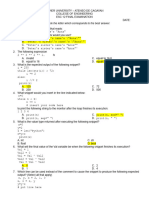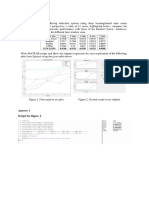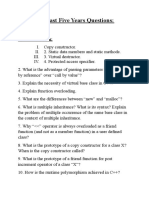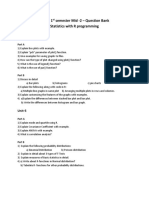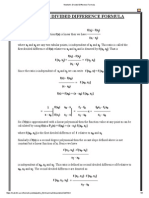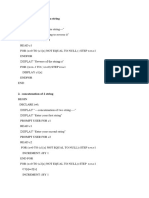0 ratings0% found this document useful (0 votes)
320 viewsMatlab Assignment Questions
The document provides two Matlab assignment questions. The first asks to solve a system of 3 equations using determinants, Cramer's rule, and Gauss elimination with partial pivoting, then check the solution. The second asks to convert constraints about a 4-digit number into matrix form, write code to solve it using Gauss elimination with partial pivoting, and verify the solution.
Uploaded by
Arun SankarCopyright
© © All Rights Reserved
Available Formats
Download as DOCX, PDF, TXT or read online on Scribd
0 ratings0% found this document useful (0 votes)
320 viewsMatlab Assignment Questions
The document provides two Matlab assignment questions. The first asks to solve a system of 3 equations using determinants, Cramer's rule, and Gauss elimination with partial pivoting, then check the solution. The second asks to convert constraints about a 4-digit number into matrix form, write code to solve it using Gauss elimination with partial pivoting, and verify the solution.
Uploaded by
Arun SankarCopyright
© © All Rights Reserved
Available Formats
Download as DOCX, PDF, TXT or read online on Scribd
You are on page 1/ 1
Matlab Assignment Questions
1. Given the system of equations
3x2 + 7x3 = 2 ..(i)
x1 + 2x2 x3 = 3 ...(ii)
5x1 2x2 = 2..(iii)
(a) Compute the determinant.
(b) Use Cramers rule to solve for the xs
(c) Use Gauss elimination with partial pivoting to solve for the xs.
(d) Substitute your results back into the original equations to check your solution.
2. Generate a four digit number that satisfies the following properties
The sum of all the digits is 15
The third digit subtracted from the first digit is 4
The last digit is half the second digit
Sum of first and third digit gives the second digit
a) Convert the above information into Ax= B format.
b) Write a matlab code to solve the above problem using Gauss elimination
method with partial pivoting
c) Verify your result by solving using backward slash operator(\)
You might also like
- 300+ TOP MATLAB Objective Questions and Answers67% (9)300+ TOP MATLAB Objective Questions and Answers7 pages
- MATLAB Questions and Answers - Input and OutputNo ratings yetMATLAB Questions and Answers - Input and Output103 pages
- Lecture1 Chapter1 - Introduction To Digital SystemsNo ratings yetLecture1 Chapter1 - Introduction To Digital Systems47 pages
- Matlab File - Deepak - Yadav - Bca - 4TH - Sem - A50504819015No ratings yetMatlab File - Deepak - Yadav - Bca - 4TH - Sem - A5050481901559 pages
- Design and Analysis of Algorithms: Vignan University:: Vadlamudi - 522 213No ratings yetDesign and Analysis of Algorithms: Vignan University:: Vadlamudi - 522 2132 pages
- Overview of Application of Matrices in Engineering ScienceNo ratings yetOverview of Application of Matrices in Engineering Science3 pages
- Multiple Choice Question of Computational GeometryNo ratings yetMultiple Choice Question of Computational Geometry9 pages
- Experiment-01 AIM - Introduction of Matlab and Its Basic Commands0% (1)Experiment-01 AIM - Introduction of Matlab and Its Basic Commands5 pages
- Unit - II: Simultaneous Equations (MCQ) : 1 A B C D C 2No ratings yetUnit - II: Simultaneous Equations (MCQ) : 1 A B C D C 26 pages
- Python Questions and Answers - Variable Names: AdvertisementNo ratings yetPython Questions and Answers - Variable Names: Advertisement10 pages
- Lab Manual 15B17CI574 Artificial Intelligence Lab PDFNo ratings yetLab Manual 15B17CI574 Artificial Intelligence Lab PDF45 pages
- MATLAB ACTIVITY 4 - Determinant Using MATLAB: NAME: Gulla, Josiah Noel D. Section: CE21S2No ratings yetMATLAB ACTIVITY 4 - Determinant Using MATLAB: NAME: Gulla, Josiah Noel D. Section: CE21S29 pages
- Lab Record ON Matlab Simulation: Submitted By: Dharavath Pavan Kumar (31804112)No ratings yetLab Record ON Matlab Simulation: Submitted By: Dharavath Pavan Kumar (31804112)66 pages
- A Brief Introduction to MATLAB: Taken From the Book "MATLAB for Beginners: A Gentle Approach"From EverandA Brief Introduction to MATLAB: Taken From the Book "MATLAB for Beginners: A Gentle Approach"2.5/5 (2)
- Venting of Atmospheric and Low Pressure Storage TanksNo ratings yetVenting of Atmospheric and Low Pressure Storage Tanks8 pages
- A. The Equation of Continuity - Conservation of MassNo ratings yetA. The Equation of Continuity - Conservation of Mass2 pages

